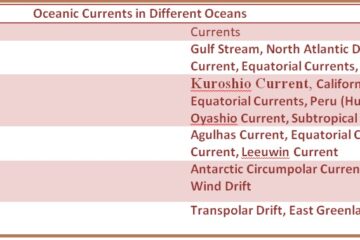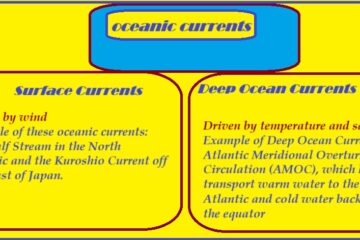Types of Oceanic Currents
Types of Oceanic Currents
Oceanic currents are classified based on their location, driving forces, and the depth at which they occur. Here’s a breakdown of the main types of oceanic currents:
1. Surface Currents (Wind-Driven Currents)
These currents occur in the upper 400 meters of the ocean and are mainly driven by wind. They play a significant role in distributing heat across the globe.
Cause: Wind patterns (trade winds, westerlies, polar easterlies) create friction with the surface of the ocean, causing water to move.
Direction: The Coriolis effect causes surface currents to move in a circular pattern, creating large gyres (circular current systems) in each ocean basin.
Examples of Surface Currents:
- Gulf Stream: A warm ocean current that originates in the Gulf of Mexico and moves northward along the eastern coast of the United States and across the North Atlantic. It helps moderate the climate of Western Europe.
- Kuroshio Current: A warm ocean current in the North Pacific that flows along the eastern coast of Japan, influencing the climate and marine ecosystems.
- Agulhas Current: A warm current that flows southward along the southeastern coast of Africa, contributing to the transfer of warm water to the Southern Ocean.
2. Deep Ocean Currents (Thermohaline Circulation)
These types of oceanic currents occur much deeper in the ocean and are driven by differences in water density, which is affected by temperature (thermo) and salinity (haline).
Cause: Water density is influenced by temperature (cold water is denser) and salinity (saltier water is denser). When cold, salty water sinks, it creates a flow of deep water that moves along the ocean floor.
Direction: These currents move very slowly and have a global, interconnected flow often referred to as the Global Conveyor Belt.
Examples of Deep Ocean Currents:
- Atlantic Meridional Overturning Circulation (AMOC): Part of the global thermohaline circulation, it brings warm water from the tropics to the North Atlantic and pulls cold, dense water from the poles toward the equator.
- Antarctic Bottom Water (AABW): Extremely cold and dense water that sinks near Antarctica and spreads across the ocean floor.
3. Tidal Currents
Tidal currents are driven by the gravitational pull of the moon and the sun, and they are the movement of water caused by the rise and fall of tides.
Cause: The moon’s gravity causes water to be pulled towards it, creating high tides and low tides. The sun also has a lesser gravitational effect, modifying the strength of tidal currents.
Direction: Tidal currents flow towards and away from shore as the tide rises and falls. They are most noticeable along coastlines, in bays, and in estuaries.
Examples of Tidal Currents:
- Flood tide: The current that moves towards the shore as the tide rises.
- Ebb tide: The current that moves away from the shore as the tide recedes.
4. Coastal Currents
Coastal currents are smaller-scale currents that occur along coastlines, often influenced by local winds, tides, and the shape of the coastline.
Cause: These currents are typically influenced by wind direction and the configuration of the coastline (e.g., bays, peninsulas, and continental shelves).
Direction: Coastal currents move parallel to the shore, either flowing inshore or offshore depending on the local conditions.
Examples of Coastal Currents:
- California Current: A cold ocean current that flows southward along the western coast of North America. It is part of the North Pacific subtropical gyre.
- East Australian Current: A warm ocean current flowing southward along the east coast of Australia, popularized in movies like Finding Nemo.
5. Upwelling and Downwelling Currents
These are vertical oceanic currents that move water either towards the surface or down into the depths.
Upwelling: The process by which deep, cold, nutrient-rich water rises to the surface. This is important for marine life as it brings nutrients that support plankton, which are the base of the food chain.
Downwelling: The process where surface water sinks, usually because of high salinity or cooling, taking oxygen and surface nutrients deeper into the ocean.
Examples of Upwelling/Downwelling:
- Peru Current (also known as the Humboldt Current): A cold upwelling current off the coast of South America that supports one of the richest marine ecosystems on the planet.
- Norwegian Sea: In the North Atlantic, cold water sinks due to cooling and high salinity, creating downwelling that affects regional ocean circulation.
6. Ekman Transport and Ekman Spiral
Ekman currents are a result of wind-driven surface currents interacting with the Coriolis effect. The movement of water in response to these forces follows a spiral pattern, known as the Ekman spiral.
- Ekman Transport: The overall movement of water caused by the Ekman spiral. It typically moves at a 90° angle to the direction of the prevailing wind.
- Ekman Spiral: The layered, spiraling movement of water, where each layer of water is deflected more than the one beneath it, creating a spiral pattern as depth increases.
7. Equatorial Currents
These are surface currents that flow along the equator, generally moving westward across the oceans due to the trade winds.
Cause: The easterly trade winds push surface waters from east to west along the equator.
Direction: These currents flow westward and help in redistributing heat and moisture.
Examples of Equatorial Currents:
- North Equatorial Current: A westward-flowing current in the North Pacific and North Atlantic.
- South Equatorial Current: A similar current in the Southern Hemisphere
you can also read:
- List of main volcanoes in the world
- List of Mountain Passes of India
- Indus river system
- Ganga river system
- Major rivers in the world
Thank you!!



0 Comments